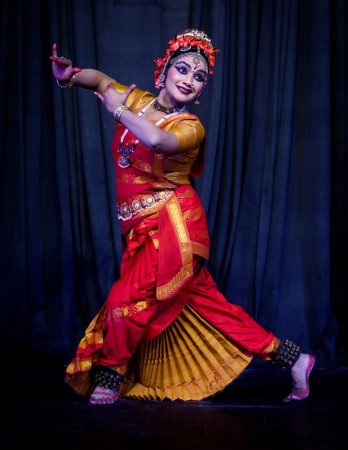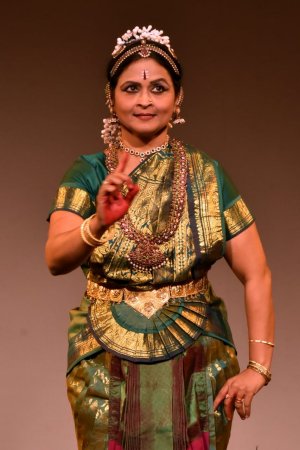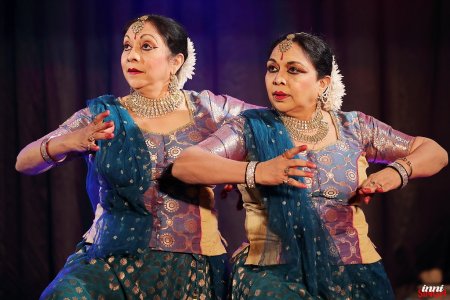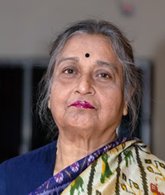
|   |

|   |
Nritya Darpan -A festival of classical dance by Suramya - Nita Vidyarthi e-mail: nitavidyarthi@gmail.com Photos courtesy: Meenu Thakur March 6, 2022 Suramya, an institution of Performing Arts, New Delhi, celebrated Azadi Ka Amrit Mahotsav by organising Nritya Darpan, a festival of Indian classical dances by featuring distinguished dancers of different disciplines of the country. It was curated by Kuchipudi dancer and UP Sangeet Natak Akademi award recipient Meenu Thakur, the Founder Director of the institution.  Meenu Thakur Meenu Thakur opened the festival with "Ganesh Udbhavam" composed and choreographed by her Guru Jayarama Rao and Vanashree Rao. Endowed with a fine stage presence, her stretched limb movements speak of classicism and clarity of definite toned body tension with crisp tala exactitude, acquired during years of training under acclaimed Gurus Swapnasundari, Natyacharya Pasumarthy Sitaramayya, Jayarama Rao and Vanashree Rao. Her energetic and impactful nritta drew special attention for its perfection.  Padmaja Suresh Bharatanatyam dancer and scholar Dr. Padmaja Suresh's presentation was deftly strategized, chiefly through the loaded lyrics of the famous poetic hymn of Adi Shankaracharya's Ardhanareeswar Ashtakam. This was preceded by Ashta Rasa taken from the verse number 51 of Saundaryalahari where the Goddess' eight emotions were portrayed in connection with her Lord. To watch Padmaja Suresh, one of the foremost dancers belonging to the Thanjavur parampara, was a privilege, especially the shifting movements and expressions from one rasa to another, beginning with sringara. The ease and fine balance of the dynamic and softer aspects of tandava-lasya elements while infusing the entire presentation with life's polarity of Shiva and Shakti - prakriti-purusha aspects - as a harmonious whole, was an insightful interpretation of the spirit of the stotram. She concluded her recital with the ritualistic Mangalam.  Aloka Kanungo Aloka Kanungo's Odissi had always earned her a special designation, be it in the nritta or in her highly sensitive abhinaya. To watch this poised dancer negotiate the intricate rhythmic compositions of the opening pure dance item by Guru Kelucharan Mohapatra in talamalika, set to raga Khamaj by Pandit Bhubaneswar Mishra as well as Kavi Jayadeva's timeless 6th ashtapadi "Sakhi hey kesi mathanamudaram" was to feel what this art form really meant in its totality. Kanungo detached her personal identity in the presentation of the ashtapadi and was totally immersed in her portrayal of the lovelorn Radha, who tells her Sakhi how desirous she is of Krishna's love. Her face had a range of expressions unfolding the poetry of the ashtapadi that captivated the viewer from the moment of her entry on to the stage. It was indeed a marvelous, involved recital.  Nalini-Kamalini Disciples of Pandit Jitendra Maharaj, the veteran dancing sisters from Delhi, Nalini and Kamalini need no introduction for the verve and sparkle of their Kathak recitals within the traditional format presentation of the Benares gharana. And of course for the popularisation of this dance form in India and abroad. They began their "jugaldharmi nritta" Shiva Stuti in chautaal 12 matra (also known as the Dhrupad Taal in the older tradition) in Dhrupadang, predominantly in madhyalaya displaying the abha (aura or halo) of Lord Shiva. After an introductory nritta they began the main piece with the invocation "angikam bhuvanam yasya, vachikam sarva vangmayam, aharyam chandra taradi, tam numah satvikam Shivam." With perfect coordination stamping the style of their Guru and ornamenting the Benares gharana, the sisters traversed the stage successively during their rendition tracing diagonals and interesting movements sideways at times with slightly raised knees. Turns which increase in speed generate excitement but those slow ones of the dancing duo expressed joy and enriched the experience. They concluded with a jugal nritya of Shiva-Parvati with a mash on the rhythm in movement with magnified effect.  Mahua Mukherjee The festival closed with a scintillating recital in a devotional vein by the distinguished Prof. Mahua Mukherjee, who is known for her pioneering work of reviving Gaudiya Nritya, the classical dance of Bengal. It is important in the presentation to concentrate on the performer and the music for its ritualistic beginning with its accessories and its characteristics. The dancer began the invocation with the ritualistic Vandana from Bhagavat after a soulful prelude by Ayan Mukherjee on the sitar with the sloka of "Namoh Brahmanya Devaya" by Pandit Amitava Mukherjee embracing ragas Bhopali and Kalyan. In true Gaudiya Nritya style she entered with a swaying "chamar" (sort of a fan made of Yak tail) in the right hand and a "sora" or Pushpadali (an earthenware plate full of flowers) in the left, which she placed in the front of the stage. Chamar and Sora are indispensable in the Vandana segment of this style of dance as mentioned in the old treatises. She picked up a round earthenware pot (handi depicting the universe), placed it on front stage with the sloka "Krishnaya Vasudeva Haraye Paramatmaney" and balanced very gracefully on it while executing hand movement of revolving the chakra with the sloka "Hey Krishna Karunasindhu…". A majestic imagery of the Godhead by the veteran dancer, who also showed a commanding stage presence in the Mangalacharan, the second item in a traditional Gaudiya repertoire. The melodious singing was a Prabandagiti of the Medini category set to Ragamala (ragamalika), Bhairav, Bhopali, Khambaj (Khamaj) and Malakoush (Malkaus). The talas used were Daspahira, Dothuki, Jhurjuti, Jhaptaal and Birbikram all from the Gaudiya nomenclature system. With excellent percussion support by Harekrishna Halder, music and research by Pandit Amitava Mukherjee, it was a gratifying and articulated performance by Prof Dr. Mahua Mukherjee. Apart from the articulate introduction by Satish, every dancer spoke briefly about their respective dance styles to make their performances worthwhile. Meenu Thakur must be lauded for her effort.  Dr. Nita Vidyarthi is a veteran critic of performing arts and writes on dance, music and theatre in leading publications. |